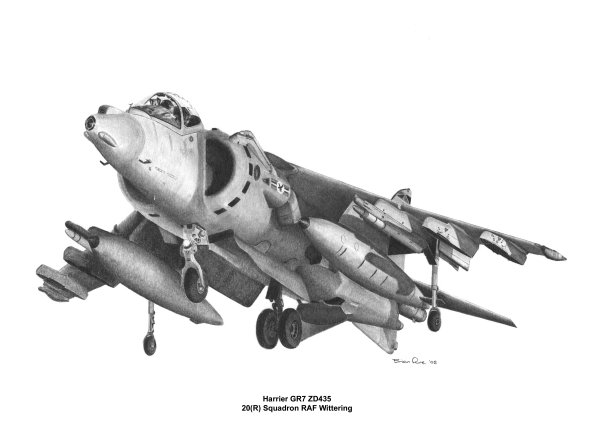
"Harrier GR7"
Ref: BF02
by Brian Fare
A3 size (297mm x 420 mm) on white 200 gsm card.
Open Edition Pencil Print
The Harrier GR7 is used by the RAF in the close air support role and is the latest in a long line of ‘jump-jets’ dating back to the introduction of the first Harriers in the 1960s.Now, as part of the Joint Force Harrier, these extremely versatile aircraft are ready to deploy anywhere in the world, either on board Royal Navy aircraft carriers or to shore bases.
The aircraft are usually employed in direct support of ground troops tackling such targets as enemy troop positions, tanks and artillery. The Harrier uses a variety of weapons such as Paveway Laser and Global Positioning System-guided bombs against buildings, Maverick infrared missiles against tanks, cluster munitions and general purpose free-fall bombs. When required, the Harrier can also be equipped with a pod fitted with cameras to provide reconnaissance of the target and battle areas.
For self-defence the aircraft can be fitted with the AIM-9L Sidewinder infrared guided missile.
The first Harriers entered RAF service in 1969, making the RAF the first in the world to use its revolutionary vertical take-off and landing abilities, which allow the aircraft to fly in and out of areas close to the battlefield that would normally be off-limits to conventional aircraft such as the Tornado. The existing versions of Harrier are the pilot-only GR7 and the two-seat T10 which, when not used as a training aircraft, can also be used in combat. The GR7A has been fitted with a more powerful engine. Key improvements introduced with the GR7 included forward-looking infrared systems, which when used with pilot's night-vision goggles, provide the capability for night-time operations. The aircraft is largely constructed of composite materials and can carry twice the ordnance load of the early model Harriers it succeeded in service.The Aircraft depicted is Harrier GR7 (ZD435) of 20 (R) Squadron, RAF Wittering.
